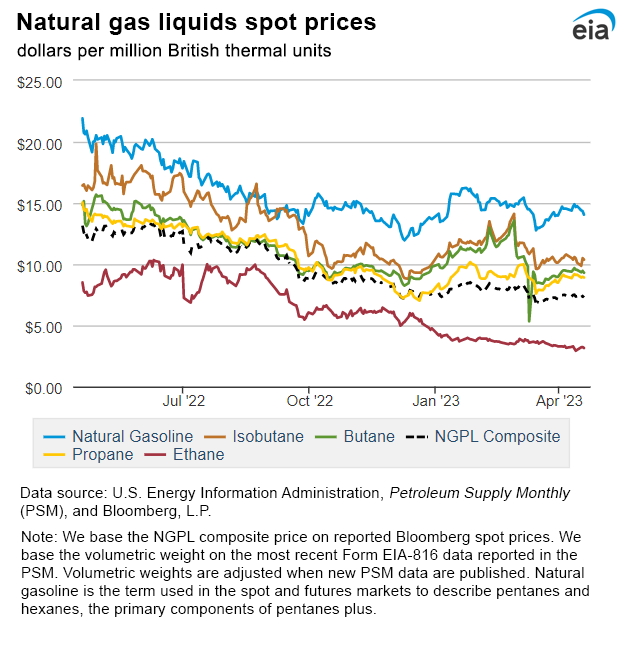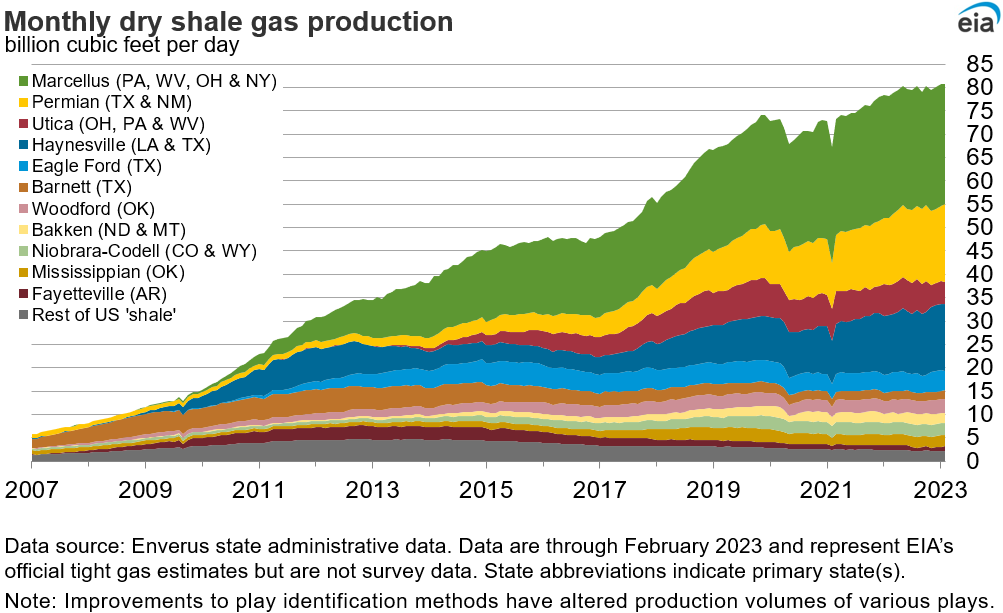In the News:
Haynesville natural gas production reached a record high in February 2023
Dry natural gas production from the Haynesville shale play in northeastern Texas and northwestern Louisiana reached new highs in February 2023, averaging 14.4 billion cubic feet per day (Bcf/d), 9% more than the annual 2022 average of 13.2 Bcf/d, according to Enverus. Haynesville natural gas production in February accounted for about 14% of all U.S. dry natural gas production.
The Haynesville is the third-largest shale gas-producing play in the United States, behind the Permian play in Texas and New Mexico, and the Marcellus play in the Appalachian Basin. In 2022, dry natural gas production averaged 25.2 Bcf/d from the Marcellus (83% of Appalachian Basin production), and 15.4 Bcf/d from the Permian play. Altogether, the Marcellus, the Permian, and the Haynesville account for 55% of U.S. dry natural gas production.
Natural gas production in the Haynesville increased in 2022, from an average 12.4 Bcf/d in January to 14.1 Bcf/d in December. Natural gas prices rose relatively steadily throughout most of 2022 as well. The U.S. benchmark Henry Hub reached a monthly high for the year in August at $8.81 per million British thermal units (MMBtu). The Henry Hub price declined in the second half of 2022 to average $5.53/MMBtu in December but was 26% higher than at the start of the year. Drilling costs in the Haynesville tend to be higher because natural gas wells in the play are deeper than in other plays. As natural gas prices rose in 2022, economics for developing new wells in the Haynesville improved, which led some producers to add more rigs in the play and increase production.
The rise in active natural gas-directed rigs in the Haynesville in 2022, as reported by Baker Hughes, followed rising natural gas prices. In the Haynesville, an average of 65 rigs were in operation in 2022, which was 43% more than the average number of active rigs in 2021. In the first three months of 2023, as natural gas prices fell, the number of active rigs in the Haynesville plateaued at about 68 rigs.
Pipeline takeaway capacity out of the Haynesville is currently estimated to be around 16 Bcf/d, according to S&P Global Commodity Insights. The Enterprise Products Partners’ Gillis Lateral pipeline and the associated expansion of the Acadian Haynesville Extension, which move natural gas from the Haynesville to demand centers and liquefied natural gas terminals along the U.S. Gulf Coast, were the most recent pipeline projects to enter service (December 2021) in the area.
In addition, three new pipeline projects that would add 5.0 Bcf/d of takeaway capacity out of the Haynesville by the end of 2024 include:
- Williams’ Louisiana Energy Gateway (1.8 Bcf/d)
- Momentum Midstream’s New Generation Gas Gathering (NG3) (1.7 Bcf/d)
- TC Energy’s Gillis Access project (1.5 Bcf/d)
Market Highlights:
(For the week ending Wednesday, April 19, 2023)Prices
- Henry Hub spot price: The Henry Hub spot price fell 1 cent from $2.21 per million British thermal units (MMBtu) last Wednesday to $2.20/MMBtu yesterday.
- Henry Hub futures prices: The price of the May 2023 NYMEX contract increased 12.9 cents, from $2.093/MMBtu last Wednesday to $2.222/MMBtu yesterday. The price of the 12-month strip averaging May 2023 through April 2024 futures contracts climbed 10.8 cents to $3.006/MMBtu.
- Select regional spot prices: Natural gas spot price changes were mixed this report week (Wednesday, April 12, to Wednesday, April 19). Prices increased at most major pricing hubs across the country compared with last Wednesday, while some prices declined in the West. Price changes from last Wednesday to yesterday at major pricing hubs ranged from a decrease of $1.23/MMBtu at Opal in southwestern Wyoming to an increase of 61 cents/MMBtu at Waha in western Texas.
- In the Northeast, prices rose this week, remaining relatively low and close to the national average price, despite fluctuating with weather. At the Algonquin Citygate, which serves Boston-area consumers, the price increased 26 cents from $1.70/MMBtu last Wednesday to $1.96/MMBtu yesterday. Daily average temperatures in the Boston Area were 69°F last Thursday, 21°F above normal, declining to 48°F yesterday, which is 3°F below normal. Total consumption of natural gas across all sectors in the Northeast declined 14% (2.4 billion cubic feet per day [Bcf/d]) week over week, led by a 30% (2.2 Bcf/d) decline in residential and commercial sector consumption, according to data from S&P Global Commodity Insights. During the week, total natural gas consumption across all sectors reached a daily high on Tuesday that was 17% higher than the weekly average.
- In the Midwest, at the Chicago Citygate, the price increased 13 cents from $1.81/MMBtu last Wednesday to $1.94/MMBtu yesterday. In the Chicago Area, temperatures averaged 57°F this week, 7°F above normal, but fluctuated during the week. Daily average temperatures in the Chicago Area began the week well above normal, reaching 74°F on Saturday, which is 24°F above normal, before declining to 36°F on Monday, 15°F below normal. Yesterday, temperatures in the Chicago Area were 53°F, slightly above normal. Consumption of natural gas in the residential and commercial sectors in the Midwest declined by 6% (0.3 Bcf/d). During the week, total natural gas consumption across all sectors reached a daily high on Monday that was 40% higher than the weekly average.
- In the West, prices generally declined this week, except for the price at PG&E Citygate in Northern California, which rose 38 cents from $5.79/MMBtu last Wednesday to $6.17/MMBtu yesterday. The price at SoCal Citygate in Southern California decreased 33 cents from $7.99/MMBtu last Wednesday to $7.66/MMBtu yesterday. In the Pacific Northwest, the price at Sumas on the Canada-Washington border fell $1.17 from $4.80/MMBtu last Wednesday to $3.63/MMBtu yesterday. Southern California Gas (SoCalGas) began planned maintenance on Line 5000 on Monday, April 17, which will curtail 630 million cubic feet per day of natural gas flows through April 28.
- The price at the Waha Hub in West Texas, which is located near Permian Basin production activities, rose 61 cents this report week, from $0.96/MMBtu last Wednesday to $1.57/MMBtu yesterday. The Waha Hub traded 63 cents below the Henry Hub price yesterday, compared with last Wednesday when it traded $1.25 below the Henry Hub price. On April 14, Kinder Morgan issued a notice that it had successfully completed inspections and maintenance of compressors at three compressor stations along the Gulf Coast Express Pipeline, restoring 0.8 Bcf/d of operational capacity to the full 2 Bcf/d of capacity.
- International futures prices: International natural gas futures prices decreased this report week. According to Bloomberg Finance, L.P., weekly average front-month futures prices for liquefied natural gas (LNG) cargoes in East Asia fell 5 cents to a weekly average of $12.56/MMBtu. Natural gas futures for delivery at the Title Transfer Facility (TTF) in the Netherlands fell 48 cents to a weekly average of $13.35/MMBtu. In the same week last year (week ending April 20, 2022), the prices were $27.16/MMBtu in East Asia and $30.06/MMBtu at TTF.
- Natural gas plant liquids (NGPL) prices: The natural gas plant liquids composite price at Mont Belvieu, Texas, fell by 9 cents/MMBtu, averaging $7.35/MMBtu for the week ending April 19. Weekly average ethane prices fell 3%, while natural gas prices at the Houston Ship Channel fell 10% week over week, widening the ethane premium to natural gas by 7%. Ethylene spot prices fell by 4%, decreasing the ethylene to ethane premium by 5%. Propane prices followed the Brent crude oil price, which remained relatively unchanged, resulting in a 1% decrease in the propane discount relative to crude oil. Normal butane and natural gasoline prices fell 1% each, while isobutane prices fell 3%.
Daily spot prices by region are available on the EIA website.
Supply and Demand
- Supply: According to data from S&P Global Commodity Insights, the weekly average total supply of natural gas rose by over 0.1% (0.1 Bcf/d) week over week. Dry natural gas production remained unchanged at 100.7 Bcf/d, while average net imports from Canada increased by nearly 3.5% (0.2 Bcf/d) week over week to average 4.7 Bcf/d.
- Demand: Weekly average total U.S. consumption of natural gas fell by 4.6% (3.3 Bcf/d) week over week to average 67.3 Bcf/d, according to data from S&P Global Commodity Insights. Natural gas consumed for power generation climbed by 0.4% (0.1 Bcf/d), while industrial sector consumption decreased by 1.7% (0.4 Bcf/d) and combined residential and commercial sector consumption declined by 15.1% (3.0 Bcf/d). Natural gas exports to Mexico increased 6.8% (0.3 Bcf/d) week over week to average 5.4 Bcf/d, and natural gas deliveries to U.S. LNG export facilities (LNG pipeline receipts) averaged 14.5 Bcf/d, a 0.8 Bcf/d increase week over week.
Liquefied Natural Gas (LNG)
- Pipeline receipts: Overall weekly average natural gas deliveries to U.S. LNG export terminals increased by 5.6% (0.8 Bcf/d) week over week to average 14.5 Bcf/d this report week, according to data from S&P Global Commodity Insights. Natural gas deliveries to terminals in South Texas increased by 19.8% (0.7 Bcf/d) to 4.5 Bcf/d, while deliveries to terminals in South Louisiana were essentially unchanged at a weekly average of 8.7 Bcf/d. Natural gas deliveries to terminals outside of the Gulf Coast were also essentially unchanged at 1.3 Bcf/d.
- Vessels departing U.S. ports: Twenty-four LNG vessels (eight from Sabine Pass; five from Corpus Christi; four each from Cameron and Freeport; two from Calcasieu Pass; and one from Cove Point) with a combined LNG-carrying capacity of 90 Bcf departed the United States between April 13 and April 19, according to shipping data provided by Bloomberg Finance, L.P.
Rig Count
- According to Baker Hughes, for the week ending Tuesday, April 11, the natural gas rig count decreased by 1 rig from a week ago to 157 rigs. One rig was added in the Marcellus and one rig was added in an unidentified producing region, while two rigs were dropped in the Haynesville and one rig was dropped in the Utica. The number of oil-directed rigs decreased by 2 rigs from a week ago to 588 rigs. The Permian added three rigs, and the Ardmore Woodford and Barnett each added one rig, while the Cana Woodford, Eagle Ford, and Granite Wash each dropped two rigs. In addition, one rig was dropped in an unidentified producing region. The total rig count, which includes 3 miscellaneous rigs, stands at 748 rigs, which is 55 more rigs than last year at this time. The total rig count has declined for three consecutive weeks.
Storage
- Net injections into storage totaled 75 Bcf for the week ending April 14, compared with the five-year (2018–2022) average net injections of 41 Bcf and last year's net injections of 47 Bcf during the same week. Working natural gas stocks totaled 1,930 Bcf, which is 329 Bcf (21%) more than the five-year average and 488 Bcf (34%) more than last year at this time.
- According to The Desk survey of natural gas analysts, estimates of the weekly net change to working natural gas stocks ranged from net injections of 60 Bcf to 82 Bcf, with a median estimate of 70 Bcf.
See also:
Top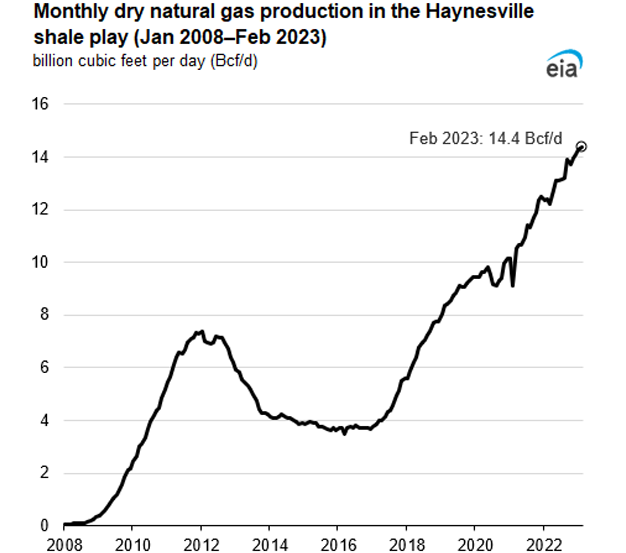
Data source: Enverus, based on state administrative data
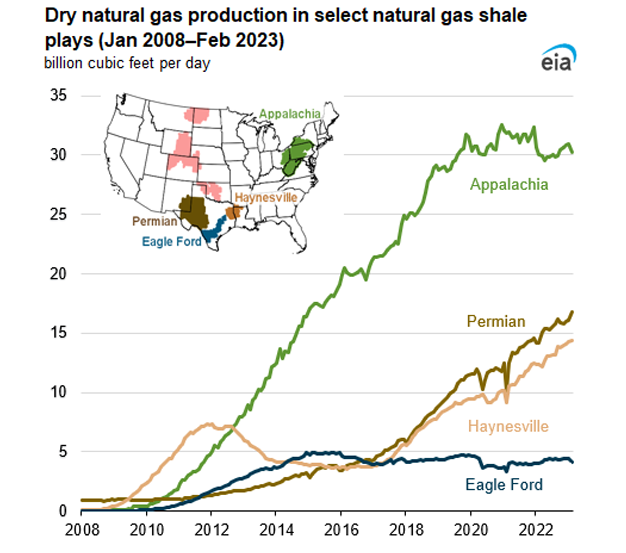
Data source: Enverus, based on state administrative data
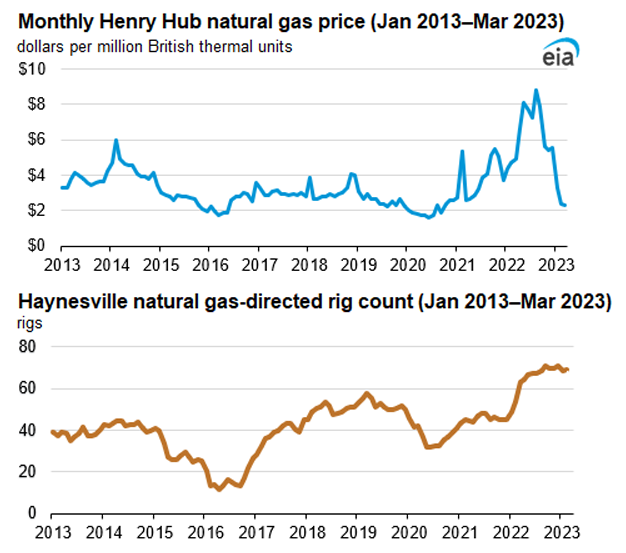
Data source: U.S. Energy Information Administration and Baker Hughes Company
Note: Rig counts are total monthly averages based on weekly estimates.
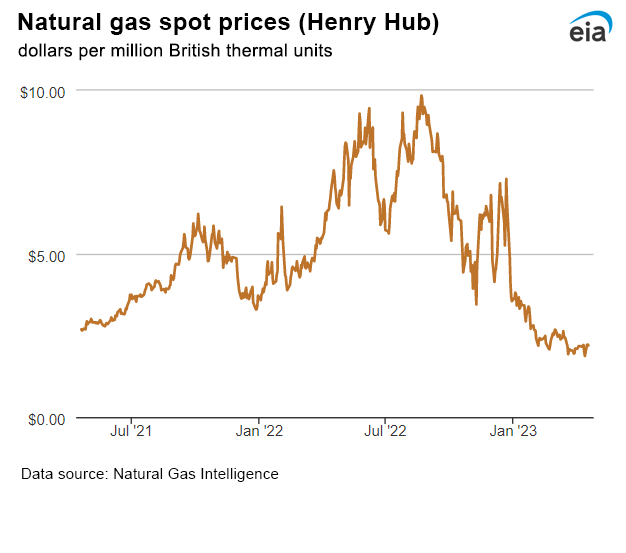
| Spot Prices ($/MMBtu) | Thu, 13-Apr |
Fri, 14-Apr |
Mon, 17-Apr |
Tue, 18-Apr |
Wed, 19-Apr |
|---|---|---|---|---|---|
| Henry Hub |
2.00 |
1.87 |
2.21 |
2.22 |
2.20 |
| New York |
1.36 |
1.35 |
1.74 |
1.79 |
1.73 |
| Chicago |
1.57 |
1.69 |
2.10 |
1.99 |
1.94 |
| Cal. Comp. Avg.* |
4.22 |
3.79 |
3.85 |
3.97 |
4.35 |
| Futures ($/MMBtu) | |||||
| May contract | 2.007 |
2.114 |
2.275 |
2.366 |
2.222 |
| June contract |
2.197 |
2.305 |
2.444 |
2.517 |
2.395 |
| *Avg. of NGI's reported prices for: Malin, PG&E Citygate, and Southern California Border Avg. | |||||
| Source: NGI's Daily Gas Price Index | |||||
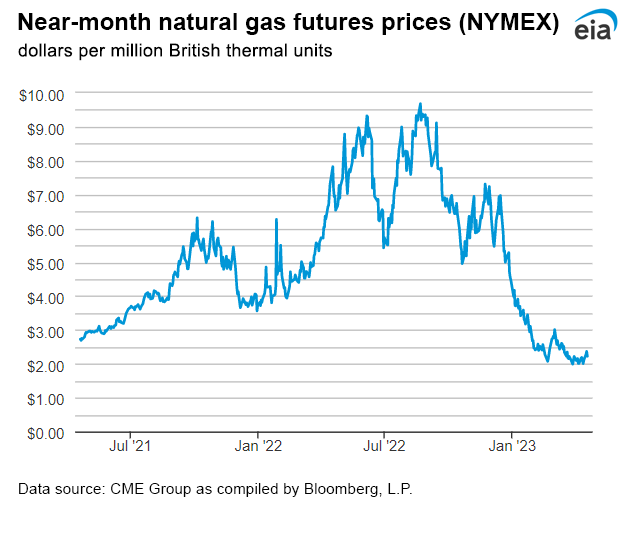
| U.S. natural gas supply - Gas Week: (4/13/23 - 4/19/23) | |||
|---|---|---|---|
Average daily values (billion cubic feet) |
|||
this week |
last week |
last year |
|
| Marketed production | 113.1 |
113.0 |
109.2 |
| Dry production | 100.7 |
100.7 |
96.2 |
| Net Canada imports | 4.7 |
4.5 |
5.4 |
| LNG pipeline deliveries | 0.1 |
0.1 |
0.1 |
| Total supply | 105.5 |
105.3 |
101.7 |
|
Data source: S&P Global Commodity Insights | |||
| U.S. natural gas consumption - Gas Week: (4/13/23 - 4/19/23) | |||
|---|---|---|---|
Average daily values (billion cubic feet) |
|||
this week |
last week |
last year |
|
| U.S. consumption | 67.3 |
70.6 |
71.0 |
| Power | 28.2 |
28.1 |
25.4 |
| Industrial | 22.2 |
22.6 |
23.2 |
| Residential/commercial | 16.9 |
19.9 |
22.4 |
| Mexico exports | 5.4 |
5.0 |
5.5 |
| Pipeline fuel use/losses | 6.7 |
6.8 |
6.6 |
| LNG pipeline receipts | 14.5 |
13.7 |
12.0 |
| Total demand | 93.9 |
96.2 |
95.2 |
|
Data source: S&P Global Commodity Insights | |||
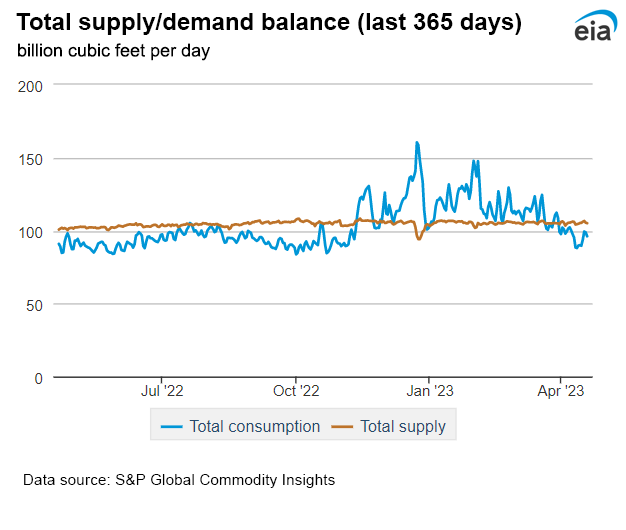
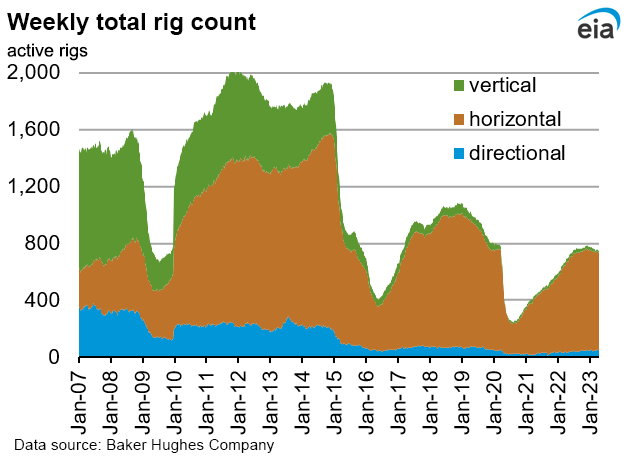
| Rigs | |||
|---|---|---|---|
Tue, April 11, 2023 |
Change from |
||
last week |
last year |
||
| Oil rigs | 588 |
-0.3% |
7.3% |
| Natural gas rigs | 157 |
-0.6% |
9.8% |
| Note: Excludes any miscellaneous rigs | |||
| Rig numbers by type | |||
|---|---|---|---|
Tue, April 11, 2023 |
Change from |
||
last week |
last year |
||
| Vertical | 19 |
35.7% |
-24.0% |
| Horizontal | 683 |
-0.4% |
7.4% |
| Directional | 46 |
-9.8% |
43.8% |
| Data source: Baker Hughes Company | |||
| Working gas in underground storage | ||||
|---|---|---|---|---|
Stocks billion cubic feet (Bcf) |
||||
| Region | 2023-04-14 |
2023-04-07 |
change |
|
| East | 363 |
345 |
18 |
|
| Midwest | 450 |
427 |
23 |
|
| Mountain | 84 |
80 |
4 |
|
| Pacific | 83 |
74 |
9 |
|
| South Central | 949 |
929 |
20 |
|
| Total | 1,930 |
1,855 |
75 |
|
| Data source: U.S. Energy Information Administration Form EIA-912, Weekly Underground Natural Gas Storage Report | ||||
| Working gas in underground storage | |||||
|---|---|---|---|---|---|
Historical comparisons |
|||||
Year ago (4/14/22) |
5-year average (2018-2022) |
||||
| Region | Stocks (Bcf) |
% change |
Stocks (Bcf) |
% change |
|
| East | 237 |
53.2 |
280 |
29.6 |
|
| Midwest | 302 |
49.0 |
339 |
32.7 |
|
| Mountain | 89 |
-5.6 |
91 |
-7.7 |
|
| Pacific | 169 |
-50.9 |
178 |
-53.4 |
|
| South Central | 645 |
47.1 |
714 |
32.9 |
|
| Total | 1,442 |
33.8 |
1,601 |
20.5 |
|
| Data source: U.S. Energy Information Administration Form EIA-912, Weekly Underground Natural Gas Storage Report | |||||
| Temperature – heating & cooling degree days (week ending Apr 13) | ||||||||
|---|---|---|---|---|---|---|---|---|
HDDs |
CDDs |
|||||||
| Region | Current total |
Deviation from normal |
Deviation from last year |
Current total |
Deviation from normal |
Deviation from last year |
||
| New England | 104 |
-41 |
-6 |
0 |
0 |
0 |
||
| Middle Atlantic | 91 |
-37 |
-14 |
4 |
4 |
4 |
||
| E N Central | 85 |
-47 |
-40 |
2 |
2 |
2 |
||
| W N Central | 78 |
-46 |
-56 |
2 |
1 |
2 |
||
| South Atlantic | 68 |
2 |
1 |
19 |
6 |
3 |
||
| E S Central | 59 |
-1 |
-10 |
0 |
-5 |
-7 |
||
| W S Central | 37 |
7 |
9 |
12 |
-5 |
-20 |
||
| Mountain | 93 |
-29 |
-43 |
7 |
0 |
-1 |
||
| Pacific | 74 |
4 |
8 |
0 |
-2 |
-7 |
||
| United States | 77 |
-23 |
-18 |
6 |
1 |
-2 |
||
|
Data source: National Oceanic and Atmospheric Administration Note: HDDs=heating degree days; CDDs=cooling degree days | ||||||||
Average temperature (°F)
7-day mean ending Apr 13, 2023
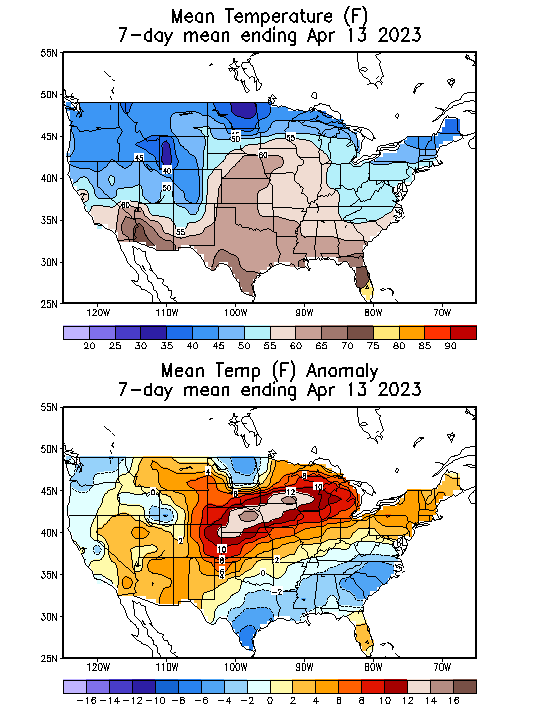
Data source: National Oceanic and Atmospheric Administration
Deviation between average and normal temperature (°F)
7-day mean ending Apr 13, 2023

Data source: National Oceanic and Atmospheric Administration

